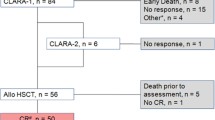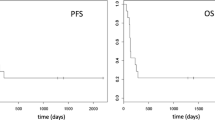Abstract
A large proportion of adult patients with acute myeloid leukemia (AML) relapse after treatment, and some of them are resistant to primary induction chemotherapy. Sixty-one patients from seven hematological centers with poor-risk AML, primary refractory (n = 16), or relapsed (n = 45) were treated with a salvage regimen, including fludarabine (2 days) and cytarabine (3 days) in a sequential continuous infusion, associated with liposomal daunorubicin (3 days) (FLAD). Complete response rate was 44% and 56% for refractory and relapsed patients, respectively, with an overall response rate of 52% (32 of 61). Twenty-two patients (36%) were resistant to the salvage therapy. Seven patients (12%) died early during chemotherapy, four of them because of sepsis. Nineteen patients in complete remission (CR) underwent a stem-cell transplant (SCT) procedure: five autologous, nine from a HL-A identical sibling, and five from HL-A matched unrelated donors. Post-treatment aplasia and mucositis were major toxicities. Twenty patients (62.5%) relapsed after this treatment in a median of 7.3 months; ten patients relapsed after a SCT procedure. Nine patients are alive and disease free; three of them were rescued after a further cytotoxic treatment. The FLAD regimen proved to be an effective and well-tolerated treatment, with acceptable toxicity in this group of high-risk patients. A better response rate was obtained in the subgroup of relapsed patients, compared to patients treated for refractory disease. More then half (five of nine) of long-surviving patients are those who were submitted to a transplant procedure; thus, the main indication for FLAD seems to be to try to induce a rapid CR with minimum toxicity in order to perform a transplant as soon as possible.




Similar content being viewed by others
References
Keating S, de Witte T, Suciu S, Willemze R, Hayat M, Labar B, Resegotti L, Ferrini PR, Caronia F, Dardenne M, Solbu G, Petti MC, Vegna ML, Mandelli F, Zittoun RA (1998) The influence of HLA-matched sibling donor availability on treatment outcome for patients with AML: an analysis of the AML 8A study of the EORTC Leukaemia Cooperative Group and GIMEMA. Br J Haematol 102:1344–1353
Zittoun RA, Mandelli F, Willemze R, de Witte T, Labar B, Resegotti L, Leoni F, Damasio E, Visani G, Papa G et al (1995) Autologous or allogeneic bone marrow transplantation compared with intensive chemotherapy in acute myelogenous leukemia. European Organization for Research and Treatment of Cancer (EORTC) and the Gruppo Italiano Malattie Ematologiche Maligne dell’Adulto (GIMEMA) Leukemia Cooperative Groups. N Engl J Med 332:217–223
Burnett AK, Wheatley K, Goldstone AH, Stevens RF, Hann IM, Rees JH, Harrison G (2002) The value of allogeneic bone marrow transplant in patients with acute myeloid leukaemia at differing risk of relapse: results of the UK MRC AML 10 trial. Br J Haematol 118:385–400
Grimwade D, Walker H, Oliver F, Wheatley K, Harrison C, Harrison G, Rees J, Hann I, Stevens R, Burnett A, Goldstone A (1998) The importance of diagnostic cytogenetics on outcome in AML: analysis of 1,612 patients entered into the MRC AML 10 trial. The Medical Research Council Adult and Children’s Leukaemia Working Parties. Blood 92:2322–2333
Leith CP, Kopecky KJ, Godwin J, McConnell T, Slovak ML, Chen IM, Head DR, Appelbaum FR, Willman CL (1997) Acute myeloid leukemia in the elderly: assessment of multidrug resistance (MDR1) and cytogenetics distinguishes biologic subgroups with remarkably distinct responses to standard chemotherapy. A Southwest Oncology Group study. Blood 89:3323–3329
Leith CP, Kopecky KJ, Chen IM, Eijdems L, Slovak ML, McConnell TS, Head DR, Weick J, Grever MR, Appelbaum FR, Willman CL (1999) Frequency and clinical significance of the expression of the multidrug resistance proteins MDR1/P-glycoprotein, MRP1, and LRP in acute myeloid leukemia: a Southwest Oncology Group Study. Blood 94:1086–1099
van den Heuvel-Eibrink MM, Wiemer EA, de Boevere MJ, van der Holt B, Vossebeld PJ, Pieters R, Sonneveld P (2001) MDR1 gene-related clonal selection and P-glycoprotein function and expression in relapsed or refractory acute myeloid leukemia. Blood 97:3605–3611
Gandhi V, Estey E, Keating MJ, Plunkett W (1993) Fludarabine potentiates metabolism of cytarabine in patients with acute myelogenous leukemia during therapy. J Clin Oncol 11:116–124
Vidarsson B, Abonour R, Williams EC, Woodson RD, Turman NJ, Kim K, Mosher DF, Wiersma SR, Longo WL (2001) Fludarabine and cytarabine as a sequential infusion regimen for treatment of adults with recurrent, refractory or poor prognosis acute leukemia. Leuk Lymphoma 41:321–331
Ossenkoppele GJ, Graveland WJ, Sonneveld P, Daenen SM, Biesma DH, Verdonck LF, Schaafsma MR, Westveer PH, Peters GJ, Noordhuis P, Muus P, Selleslag D, van der Holt B, Delforge M, Lowenberg B, Verhoef GE (2004) The value of fludarabine in addition to ARA-C and G-CSF in the treatment of patients with high-risk myelodysplastic syndromes and AML in elderly patients. Blood 103:2908–2913
Clavio M, Carrara P, Miglino M, Pierri I, Canepa L, Balleari E, Gatti AM, Cerri R, Celesti L, Vallebella E, Sessarego M, Patrone F, Ghio R, Damasio E, Gobbi M (1996) High efficacy of fludarabine-containing therapy (FLAG-FLANG) in poor risk acute myeloid leukemia. Haematologica 81:513–520
Estey EH (2000) Treatment of relapsed and refractory acute myelogenous leukemia. Leukemia 14:476–479
Montillo M, Mirto S, Petti MC, Latagliata R, Magrin S, Pinto A, Zagonel V, Mele G, Tedeschi A, Ferrara F (1998) Fludarabine, cytarabine, and G-CSF (FLAG) for the treatment of poor risk acute myeloid leukemia. Am J Hematol 58:105–109
Ferrara F, Leoni F, Pinto A, Mirto S, Morra E, Zagonel V, Mele G, Ciolli S, Magrin S, Montillo M (1999) Fludarabine, cytarabine, and granulocyte-colony stimulating factor for the treatment of high risk myelodysplastic syndromes. Cancer 86:2006–2013
Byrne JL, Dasgupta E, Pallis M, Turzanski J, Forman K, Mitchell D, Haynes AP, Russell NH (1999) Early allogeneic transplantation for refractory or relapsed acute leukaemia following remission induction with FLAG. Leukemia 13:786–791
Carella AM, Cascavilla N, Greco MM, Melillo L, Sajeva MR, Ladogana S, D’Arena G, Perla G, Carotenuto M (2001) Treatment of “poor risk” acute myeloid leukemia with fludarabine, cytarabine and G-CSF (FLAG regimen): a single center study. Leuk Lymphoma 40:295–303
Jackson G, Taylor P, Smith GM, Marcus R, Smith A, Chu P, Littlewood TJ, Duncombe A, Hutchinson M, Mehta AB, Johnson SA, Carey P, MacKie MJ, Ganly PS, Turner GE, Deane M, Schey S, Brookes J, Tollerfield SM, Wilson MP (2001) A multicentre, open, non-comparative phase II study of a combination of fludarabine phosphate, cytarabine and granulocyte colony-stimulating factor in relapsed and refractory acute myeloid leukaemia and de novo refractory anaemia with excess of blasts in transformation. Br J Haematol 112:127–137
Gabizon AA (1992) Selective tumor localization and improved therapeutic index of anthracyclines encapsulated in long-circulating liposomes. Cancer Res 52:891–896
Gill PS, Espina BM, Muggia F, Cabriales S, Tulpule A, Esplin JA, Liebman HA, Forssen E, Ross ME, Levine AM (1995) Phase I/II clinical and pharmacokinetic evaluation of liposomal daunorubicin. J Clin Oncol 13:996–1003
Cortes J, O’Brien S, Estey E, Giles F, Keating M, Kantarjian H (1999) Phase I study of liposomal daunorubicin in patients with acute leukemia. Invest New Drugs 17:81–87
Fassas A, Buffels R, Anagnostopoulos A, Gacos E, Vadikolia C, Haloudis P, Kaloyannidis P (2002) Safety and early efficacy assessment of liposomal daunorubicin (DaunoXome) in adults with refractory or relapsed acute myeloblastic leukaemia: a phase I–II study. Br J Haematol 116:308–315
Sells RA, Owen RR, New RR, Gilmore IT (1987) Reduction in toxicity of doxorubicin by liposomal entrapment. Lancet 2:624–625
Guaglianone P, Chan K, DelaFlor-Weiss E, Hanisch R, Jeffers S, Sharma D, Muggia F (1994) Phase I and pharmacologic study of liposomal daunorubicin (DaunoXome). Invest New Drugs 12:103–110
Bennett JM, Catovsky D, Daniel MT, Flandrin G, Galton DA, Gralnick HR, Sultan C (1985) Proposed revised criteria for the classification of acute myeloid leukemia. A report of the French–American–British Cooperative Group. Ann Intern Med 103:620–625
Vardiman JW, Harris NL, Brunning RD (2002) The World Health Organization (WHO) classification of the myeloid neoplasms. Blood 100:2292–2302
Shibata A, Bennett JM, Castoldi GL, Catovsky D, Flandrin G, Jaffe ES, Katayama I, Nanba K, Schmalzl F, Yam LT et al (1985) Recommended methods for cytological procedures in haematology. International Committee for Standardization in Haematology (ICSH). Clin Lab Haematol 7:55–74
Fassas A, Anagnostopoulos A (2005) The use of liposomal daunorubicin (DaunoXome) in acute myeloid leukemia. Leuk Lymphoma 46:795–802
Michieli M, Damiani D, Ermacora A, Masolini P, Michelutti A, Baccarani M (1999) Liposome encapsulated daunorubicin doubles anthracycline toxicity in cell lines showing a non-PGP related multidrug resistance. Haematologica 84:1151–1152
Clavio M, Venturino C, Pierri I, Garrone A, Miglino M, Canepa L, Balleari E, Balocco M, Michelis GL, Ballerini F, Gobbi M (2004) Combination of liposomal daunorubicin (DaunoXome), fludarabine, and cytarabine (FLAD) in patients with poor-risk acute leukemia. Ann Hematol 83:696–703
Author information
Authors and Affiliations
Corresponding author
Appendix: Participating centers and number (#) of patients enrolled
Appendix: Participating centers and number (#) of patients enrolled
Università Federico II, Napoli (Prof. Bruno Rotoli) #30
A.O.R.N. Cardarelli, XIX, Napoli (Dr. Felicetto Ferrara) #17
Ospedale Civile, Avellino (Dr. Nicola Cantore) #7
A.O.R.N. Cardarelli, TERE, Napoli (Dr. Vincenzo Mettivier) #2
Ospedale S. Giovanni Bosco, Napoli (Dr. Eustachio Miraglia) #2
Ospedale S. Gennaro, Napoli (Dr. Lucia Mastrullo) #2
Ospedale Civile, Arienzo (Caserta) (Dr. David Pagnini) #1
Rights and permissions
About this article
Cite this article
Camera, A., Rinaldi, C.R., Palmieri, S. et al. Sequential continuous infusion of fludarabine and cytarabine associated with liposomal daunorubicin (DaunoXome®) (FLAD) in primary refractory or relapsed adult acute myeloid leukemia patients. Ann Hematol 88, 151–158 (2009). https://doi.org/10.1007/s00277-008-0571-z
Received:
Accepted:
Published:
Issue Date:
DOI: https://doi.org/10.1007/s00277-008-0571-z




